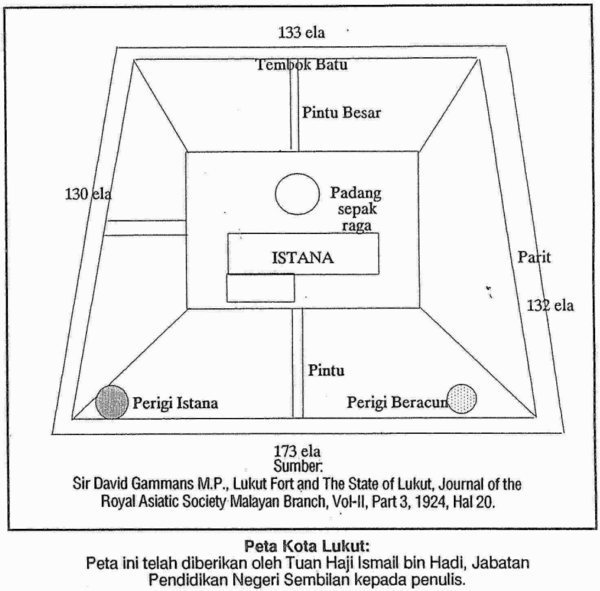Jadual Kandungan
Sempadan Selangor-Negeri Sembilan (1863-1880)
Dirujuk oleh
Ringkasan

“Sejarah pertukaran daerah Negeri Selangor - Negeri Sembilan. Tahun 1878 telah menyaksikan detik pesisir selatan Selangor (Linggi) secara rasminya diserahkan kepada Negeri Sembilan. Persempadanan semula ini adalah susulan permohonan Negeri Sembilan yang telah kehilangan kawasan pantai selepas perluasan kuasa Selangor menjelang kurun ke-19. Sebagai ganti, Negeri Sembilan memberikan sebahagian Sungai Ujong (termasuk Semenyih, Beranang, Réko dan Broga) kepada Selangor.
Sehingga ke hari ini, kesan persempadanan semula kedua negeri ini kita dapat lihat dari segi penduduknya:
1. Pesisir Negeri Sembilan (Linggi, Port Dickson) bertutur dalam Bahasa Melayu yang agak mirip dengan Selangor, dari segi demografik juga ramai berketurunan Bugis dan tidak mengamalkan Adat Perpatih.
2. Manakala kawasan Semenyih di Selangor mempunyai adat, bahasa, seni bina dan warisan yang menghampiri Negeri Sembilan.”
(Facebook Pekan Bangi, 30 Julai 2025: "Sejarah pertukaran daerah Negeri Selangor - Negeri Sembilan").
Urutan Peristiwa
1815-1878: Lukut Di Bawah Selangor
Raja Busu (1815-1834)
Peluasan pengaruh Bugis di Selangor telah pun berlangsung sejak awal kurun ke-18 lagi. Sungai Sepang yang dahulunya di dalam Negeri Sembilan, telah jatuh ke tangan mereka. Lukut khususnya, mula diduduki pada tahun 1815, seiring dengan kegiatan melombong bijih timah di sana. Raja Busu (Raja Hassan Bin Raja Nala ibni Almarhum Sultan Salehuddin), anak bongsu kepada salah seorang putera Sultan Selangor yang pertama, melantik dirinya sebagai Raja Lukut yang pertama:-
- “Awal abad ke 19, Lukut adalah salah sebuah wilayah yang berasingan di Selangor di samping Kelang, Bernam dan Selangor, Anak-anak raja yang memerintah wilayah-wilayah Ini bersedia menggunakan kekerasan untuk menentang sebarang percubaan hendak melemahkan kekuasaan mereka, ataupun untuk merampas kekayaan mereka. Lukut mula-mula dibuka oleh Raja Busu, iaitu seorang anggota keluarga diraja Selangor. Kebanyakan pengikutnya datang dari Sungai Selangor dan Kedah. Menjelang tahun 1815, pelombong-pelombong Cina diketahui telah menjalankan kerja-kerja melombong di situ. Dalam tahun 1815 daripada jumlah penduduk Lukut yang seramai 1,000 orang, kira-kira 200 orang daripadanya adalah orang Cina di mana kemudian Seorang kapitan Cina telah dilantik oleh Sultan Ibrahim.” (Zulkapli Othman; Mohd Khalid Yasin @ Warisan: Jurnal Persatuan Sejarah Malaysia cawangan Negeri Sembilan 18 m.s.59-37 (1994): |"Sejarah Lukut", m.s.2-3).
- “Lukut, although attaining apparently at one period to the dignity of an independent state, has not a very long or exciting history to its credit. It was founded by Raja Busu, a Selangor Malay, who collecting together a band of followers from Selangor, Kedah and other parts, came and settled on the banks of the Lukut River. The actual settlement has long since disappeared, but a few attap shops and unexceptionally large mosque on the Port Dickson—Seremban Road at about 4 1/2 miles from Port Dickson mark the site. The overgrown swamp on the right hand side of the road coming from Seremban, just after passing the Bukit Palong—Sepang Road, was apparently an estuary of the Lukut before mining silted it up. In the prosperous days which were to follow, as many as twenty tongkangs with dozens of prahus could be seen anchored in this haven at one time.” (L.D. Gammans @ Journal of the Malayan Branch of the Royal Asiatic Society Vol. 2, No. 3 (92) (December 1924), pp. 291-295: "The State of Lukut. (With text figures)").
- “During the start of the 18th century CE, the Bugis were already establishing their foothold on the west coast of the peninsula and had taken control of the coastline, starting from the mouth of Sungai Linggi in the south (Selangor’s border with Melaka), and stretching to the Bernam river valley at the border with Perak in the north. Tin had taken over from spices as the main trade commodity. The Chinese started mining (for gold and tin) in Melaka from 1793 and, by early 1800, they had ventured into neighbouring Sungai Ujong and Lukut. Records show that the Chinese were already mining for tin in Lukut from 1815. When John Anderson visited Selangor in 1818 to carry out a survey on the economy and population, he reported that Lukut had ‘lately become a great place for tin’ and the Chinese had formed a fifth of the total population of a thousand people in Lukut. In the 1820s, Raja Busu (full name Raja Hassan Bin Raja Nala ibni Almarhum Sultan Salehuddin), the youngest son of Sultan Salehuddin, the first Sultan of Selangor, attracted by the rich tin deposits, took control and proclaimed himself the first Malay Ruler of Lukut. Raja Busu ruled the settlement as an independent district and he brought in more Chinese from Melaka to expand the output of the mines. The Malays were already mining for tin using the ‘lampang’ (sluicing) but the Chinese mining technique of ‘lombong’ (opening larger pits) was more effective in getting a larger yield. Lukut saw the start of tin mining using Chinese labour, technique and capital.” (Eric Lim @ Museum Volunteers, JMM, August 23, 2021: |"A Very Rough Guide To Lukut").
1834: Pembunuhan Raja Busu
Akibat kekecohan melibatkan kongsi gelap di Lukut, Raja Busu telah terbunuh bersama seluruh ahli keluarganya, di dalam suatu kekecohan di kediamannya pada September 1834:-
“Kita sering diceritakan pembunuhan Raja Busu berpunca daripada cukai yang tinggi. Dalam artikel Zulkapli dan Mohd Khalid yang diterbitkan oleh Persatuan Sejarah Malaysia Caw. Negeri Sembilan (Warisan) pada tahun 1994, menyebut Raja Busu mengenakan cukai 10% peratus daripada hasil keluaran bijih di Lukut. (salah satu contoh penulisan mengenai Lukut)
Rujuk pula dalam Triad & Tabut~~.
“Then follow a recital of murders and outrages committed by the society (doubtless the Ghee Hin) in Malacca in 1826, whose headquarter appears to have been at the tin mines at Lukut, outsides Malacca territory”.
Ini bermaksud bangunan operasi Ghee Hin terletak di Lukut. Kawasan Lukut dikuasai oleh Ghee Hin. Bagi Hai San pula, beroperasi dan berkuasa di Sungei Ujong.
1828, berlaku pergaduhan antara Ghee Hin dan Hai San di Lukut. Hai San dari Sungei Ujong telah menyerang Gheen Hin. Ramai pengikut Ghee Hin terbunuh dan rumah dimusnahkan. Bangunan kongsi dirampas oleh Hai San. Namun, Hai San tidak duduk di Lukut. Mereka balik semula ke Sungei Ujong. Dalam pergaduhan antara Hai San dan Ghee Hin, ada perkampungan Melayu turut dibakar dan penduduknya dibunuh.
Dalam tahun yang sama, orang Melayu Sungei Ujong telah menyerang lombong yang diusahakan oleh Ghee Hin. Membunuh semua pengikut Ghee Hin dan merampas hasil bijih.
1834, Ghee Hin membalas dendam dengan menyerang Istana Raja Busu. Istana Raja Busu dibakar. Raja Busu dan keluarganya dibunuh. Perkampungan Melayu yang berada berhampiran turut dimusnahkan.
Wynne tidak menyebut pembunuhan Raja Busu berpunca daripada cukai. Begitu juga Newbold.
Dalam laporannya Newbold menulis hasil lombong di Lukut diserahkan kepada Selangor sebanyak 10%. Ini bermakna sejak daripada awal lagi pelombong Cina memang dikenakan cukai sebanyak 10% kepada Selangor. Bukan Raja Busu yang menaikkan cukai sebanyak 10%.
Kedua-dua laporan Wynne dan Newbold~~~ merumuskan bahawa pembunuhan Raja Busu berpunca daripada pergaduhan antara Hai San dan Gheen Hin. Akibatnya, orang Melayu Sungei Ujong bertindak balas. Tindakan ini dibalas pula oleh Ghee Hin dengan membakar Istana Lukut milik Raja Busu dan membunuhnya.
Selepas Perjanjian Rembau - British 1835, Ghee Hin di Melaka telah dibenarkan untuk membuka cawangan di Lukut dan Sungei Ujong secara sah oleh British.
Bagaimana kisah kenaikan cukai oleh Raja Busu menjadi punca Raja Busu dibunuh? Bila cerita Lukut atau Raja Busu, mesti isu cukai diketengahkan seolah-olah Raja Busu seorang yang zalim.
Setiap kali mengenai kejatuhan sesuatu kerajaan atau negeri mesti dikaitkan dengan kezaliman raja atau pemerintah. Kita tidak pernah melihat apakah peranan yang dimainkan oleh British dan kapitalis yang ingin menguasai ekonomi Tanah Melayu pasa masa itu. Akhirnya kita didedahkan dengan sejarah seolah-olah raja Melayu tamak dan sentiasa bergaduh sedangkan sejarah atau peristiwanya berbeza.
——–
~~ Triad & Tabut ditulis oleh Wynne mengenai gerakan kongsi gelap di Tanah Melayu. Beliau merupakan seorang pegawai intelijen polis.
~~~ Newbold pula seorang pegawai tentera British yang bertugas di Melaka.
—–
Jika dibaca keenam-enam jilid Triad Societies, kita akan memahami gerakan dan mainan British dan kapitalis menggunakan kongsi gelap untuk mengawal dan menguasai ekonomi di negeri-negeri Melayu dalam kurun ke-19.”
(Sumber: Mohd Khairil Hisham, 15 April 2022: "Sejarah kurun ke-19 lebih sakit untuk dibincangkan kerana melibatkan pihak luar yang cuba mengaut keuntungan hasil di sini...").
(Sumber rujukan beliau: M.L. Wynne, 1941: "Triad and Tabut: a survey of the origin and diffusion of Chinese and Mohamedan Secret Societies in the Malay Peninsula, 1800-1935").
Raja Jumaat (1846-1864)
Setelah lebih 10 tahun diabaikan sejak peristiwa kekecohan 1834, Lukut dibangunkan semula di bawah pemerintahan Raja Jumaat, dan mencapai zaman kegemilangannya:-
- “Peringkat yang paling cemerlang dalam sejarah Lukut bermula apabila Lukut terletak di bawah pemerintahan Raja Jumaat bin Raja Jaafar. Pada tahun 1836, Sultan Mohamad (Sultan Selangor ke tiga 1826 - 1857) telah datang ke Lukut dari Kuala Selangor bersama-sama dengan beberapa orang pengiring. Baginda telah melantik Raja Jumaat sebagai wakil baginda di situ. Raja Jumaat berkahwin dengan puteri Sultan Muhamad, iaitu Tengku Senai (Tengku Nai). Pada tahun 1846 Sultan Muhamad memberi kuasa kepada Raja Jumaat untuk memerintah Lukut dan mengambil hasil cukai di daerah itu. Jumaat Juga dilantik oleh Sultan Mohamad sebagai Penasihat Keluarga Kesultanan Selangor bergelar Raja Tua. Raja Jumaat (meninggal 1864) menjadi sahabat karib Residen Councillor di Melaka. Baginda berhubung rapat dengan Kerajaan Selat, mendermakan sebidang tanah untuk membina rumah api, bekerjasama dalam kempen menentang lanun dan membantu menangkap penjenayah-penjenayah yang melarikan diri. Di bawah pentadbiran Raja Jumaat, Lukut merupakan sebuah negeri contoh dan kesediaan baginda memperkenalkan bentuk dan cara kerajaan kita mendapat kepercayaan tinggi baginya di mata Inggeris. … Menjelang awal tahun 1860'an dilaporkan bahawa Raja Jumaat telah dianugerahkan oleh sultan dengan kuasa yang tertinggi ke atas seluruh Selangor.” (Zulkapli Othman; Mohd Khalid Yasin @ Warisan: Jurnal Persatuan Sejarah Malaysia cawangan Negeri Sembilan 18 m.s.59-37 (1994): |"Sejarah Lukut", m.s.4-5,9).
- “Raja Jumaat appears to have been an ideal leader, respected by Malays and Chinese: he set about energetically to put his state in order: he extended his dominion southwards until the whole of the Coast line of what is now Negri Sembilan from the Sepang to the Linggi was under his sway. Raja Sulaiman of Sungai Raya, Pasir Panjang, of whom we shall hear more anon, owed allegiance to him. … As soon as the fairness of Jumaat's rule being widely shown, settlers poured in from all parts anxious to put themselves under the protection of a man who combined of character with honesty of purpose. A resident population of Chinese—mostly Hylams — established itself in sufficient numbers to warrant a double row of more than 40 brick shop houses, the foundations of which are visible to this day. In 1860 the State was visited by Captain Macpherson, Resident Councillor, Malacca, whose report is of great interest: 'The contrast between Lukut and Selangor is very striking: indeed the former can well bear comparison with any European Settlement: and it is equally and gratifying in the midst of a dense jungle to come suddenly upon the footprints of advanced civilisation. The roads are well formed and macadamized: the (as yet) only street of China town is uniformly built of brick and tiled roof, kept scrupulously clean and well-drained: the godowns on the river's bank are large and massively built, and both the people and the place have an air of contentment and prosperity.'” (L.D. Gammans @ Journal of the Malayan Branch of the Royal Asiatic Society Vol. 2, No. 3 (92) (December 1924), pp. 291-295: "The State of Lukut. (With text figures)").
- “This was during the reign of the third Sultan of Selangor, Sultan Muhammad, who took the opportunity to assert his authority and proclaimed Lukut as part of Selangor in 1836. In 1846, Sultan Muhammad announced the appointment of Raja Jumaat as Chief of Lukut. Prior to this, Raja Jumaat together with his father, Raja Jaafar and brother, Raja Abdullah, had settled in Lukut for some time. They were Bugis from Riau, Indonesia. The appointment of Raja Jumaat eventually turned out to be crucial and important for the town and the Sultan. Under his leadership, a well laid out township took shape with a main street and a double row of brick shophouses with tile roofs, large godowns and a customs house. He even set up a police force of twenty Malays attired in uniforms and hats with identification numbers. Chinese traders, mainly Hailam, set up their businesses in the town. As his residence, he built a fort on top of a hill overlooking the town and protected by cannons around the parameters. He had established good business relationships with Melaka businessmen and friendship with Lieutenant Colonel Ronald MacPherson who was the Resident Councillor (chief administrator) at Melaka between 1857 and 1860. Lukut reached the peak in tin production and the settlement became prosperous and flourished under Raja Jumaat.” (Eric Lim @ Museum Volunteers, JMM, August 23, 2021: |"A Very Rough Guide To Lukut").
Raja Bot bin Raja Jumaat (1864-1880)
Setelah kematian Raja Jumaat pada tahun 1864, keadaan di Lukut beransur merosot, akibat pelbagai konflik serta hasil bijih timah yang berkurangan:-
- “Kematian Raja Jumaat pada tahun 1864 digantikan Raja Bot. Dalam tahun permulaan pemerintahan Raja Bot, Kota Lukut menjadi bertambah besar. Raja Bot menggaji kira-kira 30 orang Arab dan seterusnya orang Arab menetap di Lukut serta berkahwin dengan orang tempatan.” (Zulkapli Othman; Mohd Khalid Yasin @ Warisan: Jurnal Persatuan Sejarah Malaysia cawangan Negeri Sembilan 18 m.s.59-37 (1994): |"Sejarah Lukut", m.s.9).
- “Like his father Bot contended himself with a modest revenue of 10% of all exports of tin. Raja Bot enlarged the fort and brought over a mercenary army of about 30 Arabs to fight for him. They lived round about, intermarried with the Malays and are undoubtedly responsible for the Arab strain which is clearly visible in many of the local Malays to this day. Very early in his reign he was called upon to cope with the only two disturbances in the history of Lukut.” (L.D. Gammans @ Journal of the Malayan Branch of the Royal Asiatic Society Vol. 2, No. 3 (92) (December 1924), pp. 291-295: "The State of Lukut. (With text figures)").
- “When Raja Jumaat died in 1864, it was a big blow to Lukut as it began to decline and the situation was made worse with the gradual depletion of its tin deposits. … During an early stage of his rule, Raja Bot had to face several disturbances. Raja Sulaiman of Sungai Raya had wanted to break away from Lukut and this prompted him to lead an attack on Lukut. Raja Bot and his men managed to stop the attack, even without the protection of his band of 30 Arab mercenaries as they had fled the scene after seeing one of them being stabbed to death. The next incident happened when Raja Yahya, adopted son of Sultan Abdul Samad, paid a visit. On the way to meeting Raja Bot, he had caught a Chinese Hailam whom he executed, without the permission of Raja Bot. When the Chinese arrived seeking an explanation, a melee ensued but Raja Yahya managed to escape. Then there was an incident where a Malay Raja set the Chinese bazaar on fire. These disturbances greatly affected the relationship between the Chinese and Malays and the prosperity of Lukut. Chinese miners started to head out to the more successful mines in Hulu Klang and Ampang in the north.” (Eric Lim @ Museum Volunteers, JMM, August 23, 2021: |"A Very Rough Guide To Lukut").
1830-1878: Rekoh, Beranang, Semenyih Di Bawah Sungai Ujong
Sementara itu, kawasan pedalaman sebelah selatan Sungai Langat (termasuk kawasan yang bakal dibuka sebagai Rekoh) adalah hutan belantara yang hanya didiami oleh orang asli (Temuan), dan menjadi sempadan di antara Klang dan Sungai Ujong. Setelah Sultan Abdul Samad menduduki Kuala Langat, warga Selangor mula meneroka ke hulu Sungai Langat sehingga ke kawasan Kajang (Rekoh). Dalam masa yang sama, Raja Hussein membuka petempatan di Beranang dan Semenyih, di bawah Dato' Klana Sungai Ujong: “A much more debatable claim is laid to that part of Selangor which lies south of the Langat River. The legend runs that the earliest settlements of aboriginees in Sungei Ujong lay between Lenggeng and the Langat river, which was then the boundary between the States of Sungei Ujong and Klang. It is generally agreed that there were no Malay settlements of any importance in this area until the third quarter of the nineteenth century. Then Sultan Abdul Samad took up residence at Kuala Langat and Selangor immigrants came upstream to Kajang, where they settled down under the rule of a son of the Sultan. On the Sungei Ujong side of the river one Raja Hussein founded settlements at about the same time at Beranang and Semunyeh under the auspices of the Dato' Klana of Sungei Ujong. This Raja Hussein was a descendant of Raja Ali of Rembau but he was also a waris of Sungei Ujong through his mother. Raja Hussein did not marry a woman of the waris and his children who claimed after him were not waris of Sungei Ujong.” (J. M. Gullick @ Journal of the Malayan Branch of the Royal Asiatic Society Vol. 22, No. 2 (148), Sungei Ujong (May 1949), pp. 1-69: "Sungei Ujong", m.s.3).
Perincian persempadanan Kelang-Sungai Ujong, menurut Terombo Sungai Ujong (1901):-
“FASAL 11. Sempadan Sungai Ujong Dengan Dato'-dato' Yang Empat, Kelang, Sg. Ujong, Jelebu dan Johol. 11.1. Kawasannya yang telah dibuka oleh Batin-Batin dibawah pemerentah masing-masing iaitu Batang Langat, Kuala Labu, Bukit Jukerah, Lalu ke Tunggul Sejaga, Semonyeh terus ke Merbok Awang Hilir Rakoh, Subang Hilang, antara Kajang dan Rakoh terus ke Bukit Perhentian Rimbun perbatasan dengan Pahang. 11.2. Sebelah kiri mudik Sungai Langat di punyai oleh Kelang. Sebelah Kanan mudik Sungai Langat Sungai Ujong punya.” (Susunan Haji Muhammmad Tainu dan Zaini bt. Abd. Hamid, Jawatan Kuasa Penyelidikan Budaya Negeri Sembilan, November 1993, berdasarkan Raja Aman Raja Hussin, 1901: Terombo Sungai Ujong: |"Rengkasan Terombo Sungai Ujong", m.s.9-10).
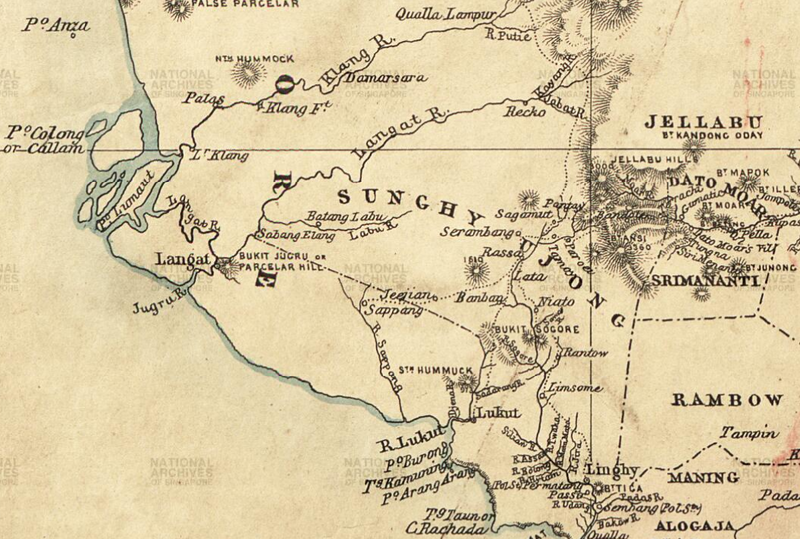
Peta sempadan Selangor-Sungai Ujong, 1876. Ketika itu Rekoh (Recko) masih di bawah pengaruh Sungei Ujong, manakala Lukut di bawah Selangor: “compiled from sketch surveys made by Captain Innes R E, J W Birch and D Daly, and Admiralty Charts. Lithographed under the direction of Lt. Col. R. Home C.B.R.E” (Royal Geographical Society, London; Royal Geographical Society (Great Britain), 1876: |"Map of Part of The Malay Peninsula, 1876").

Peta sempadan Selangor-Sungai Ujong, 1876 (versi John Murray): “Relief shown by hachures and spot heights. British possessions [Malacca, Tulu Saggar or False Dinding, Wellesley Province, and Pulo Penang] colored red. Perak, Quedah, Salangore, and consituent territories of Nigri Simbilan are shown. From: The Journal of the Royal Geographical Society of London. Vol. 46 (1876), pp. 357-80; held in Firestone Library. Call number: G7 .J687 v. 46 1876” (John Murray @ Princeton University Library, 1876: |"Sketch map of Perak and adjacent native states to illustrate the paper by W. Barrington D'Almeida").
LATAR PERISTIWA: Rekoh.
1863-11-24: Konflik Sempadan Selangor-Sungai Ujong
Pada awal 1860-an, pengaruh ini terus berkembang sehingga ke Sungai Linggi, iaitu kawasan Dato' Kelana Sending, Sungai Ujong. Berikutan itu, konflik persempadanan Selangor-Sungai Ujong mulai memuncak:-
“Pada hari ini dalam tahun 1863, Raja Abdullah dan Dato' Kelana Sending telah berunding mengenai pertelingkahan sempadan negeri Selangor dan Sungai Ujong. Turut hadir dalam perundingan itu ialah Residen Melaka, Kaptain Playfair, yang bersahabat baik dengan Dato' Kelana Sending. Masalah sempadan di antara negeri Selangor dengan Sungai Ujong berpunca bila orang-orang Bugis mulai bertapak dan berpengaruh di Selangor di awal abad ke-18. Kedudukan Sungai Sepang pada asalnya adalah di dalam Negeri Sembilan tetapi telah menjadi wilayah Selangor semasa orang-orang Bugis memperluaskan kuasa hingga ke Sungai Linggi. Sungai Linggi merupakan kawasan Dato' Kelana Sending. Beliau bertanggungjawab terhadap kutipan hasil cukai bijih di kawasan itu. Dalam tahun 1866, masalah sempadan negeri Selangor - Sungai Ujong timbul semula. Akhirnya pada 11 Julai 1868, Sultan Abdul Samad secara bertulis menyerahkan Sungai Linggi kepada Dato' Kelana Sending sebagai batas sempadan kedua-dua negeri. Keputusan ini telah ditentang oleh pembesar-pembesar Kelang dan Lukut dan akhirnya pertelingkahan terus berlarutan. Sehingga beberapa tahun bertelingkah akhirnya Residen Selangor, B. Douglas, Residen Sungai Ujong P.J. Murray, Sultan Abdul Samad dan Dato' Kelana telah dapat menyelesaikan masalah sempadan kedua-dua negeri itu melalui satu perjanjian pada tahun 1878. Dengan termeterainya perjanjian itu sempadan negeri Selangor dan Sungai Ujong ditetapkan iaitu di Sungai Sepang.” (Hari Ini Dalam Sejarah @ Arkib Negara Malaysia, Selasa 24/11/1863: |"RUNDINGAN MENGENAI PERTELINGKAHAN SEMPADAN DI ANTARA SELANGOR DENGAN SUNGAI UJONG").
1878-02-10: Penyerahan Rekoh kepada Selangor
Di dalam suatu perjanjian yang ditandatangani pada 10 Februari 1878, Rekoh telah diserahkan kepada Sultan Abdul Samad, lalu dengan rasminya menjadi sebahagian daripada negeri Selangor:-
“Pada hari ini dalam tahun 1878, satu perjanjian mengenai sempadan negeri Selangor dan Sungai Ujung dibuat di antara Sultan Abdul Samad, Yang di-Pertuan Negeri Selangor dengan Dato' Kelana Sungai Ujung, Tengku Saiyid Abdul Rahman. Perjanjian itu antara lain menyatakan bahawa:-
Pertama: Dengan nasihat Kapten Bloomfield Douglas (Residen British di Selangor) Sultan Abdul Samad, bagi pihak dirinya, dan puteranya Raja Musa atau sesiapa juga penggantinya yang akan ditabalkan sebagai Sultan dan waris-warisnya, mulai saat itu mengaku bahawa kawasan Lukut yang pada masa itu diperintah oleh Raja Bot dan semua kawasan tanah dalam Sungai Raya yang sekarang diperintah oleh Raja Daud, yang kesemuanya itu adalah di bawah kekuasaan Sultan Abdul Samad.
Kedua: Dengan nasihat Kapten Murray (Residen British di Sungai Ujung), Tengku Saiyid Abdul Rahman bagi pihak dirinya, pengganti-penggantinya dan waris-warisnya atau sesiapa juga yang memerintah Sungai Ujung dan bergelar Dato' Kelana, mengaku bahawa mulai dari saat itu kawasan yang terletak di Seberang Tebing Sungai Langat bernama Rekoh dan semua tanah bernama Labu adalah diserahkan kepada Sultan Abdul Samad Selangor, pengganti-penggantinya dan waris-warisnya untuk selama-lamanya.
Bagaimanapun, perjanjian itu telah dibantah oleh Raja Bot yang memerintah Lukut kerana beliau tidak diajak berunding mahupun diminta pendapatnya dalam rundingan mengenai perjanjian itu. Raja Bot membantah keras mengenai keputusan memasukkan Lukut dalam perintah Sungai Ujung kerana daerah itu adalah kepunyaan ayahandanya, Raja Jumaat, yang telah diberikan oleh Almarhum Sultan Muhammad pada tahun 1846.”
(Sumber: Hari Ini Dalam Sejarah @ Arkib Negara Malaysia, Ahad 10/02/1878: |"PERJANJIAN SEMPADAN SELANGOR - SUNGAI UJUNG").
“In 1878, the British wanted to settle the long-standing boundary problem, brought up by Dato Kelana Sending of Sungai Ujong for a claim of the Lukut district including Cape Rachado (Tanjung Tuan today). Raja Bot, who was not consulted, protested strongly against the transfer of Lukut to Sungai Ujong.” (Eric Lim @ Museum Volunteers, JMM, August 23, 2021: |"A Very Rough Guide To Lukut").
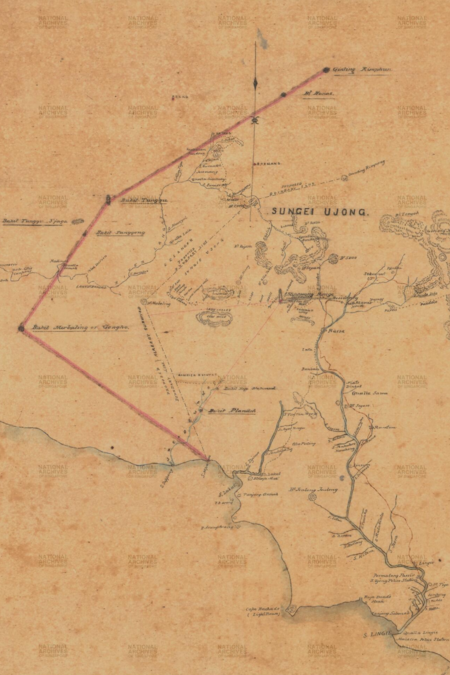
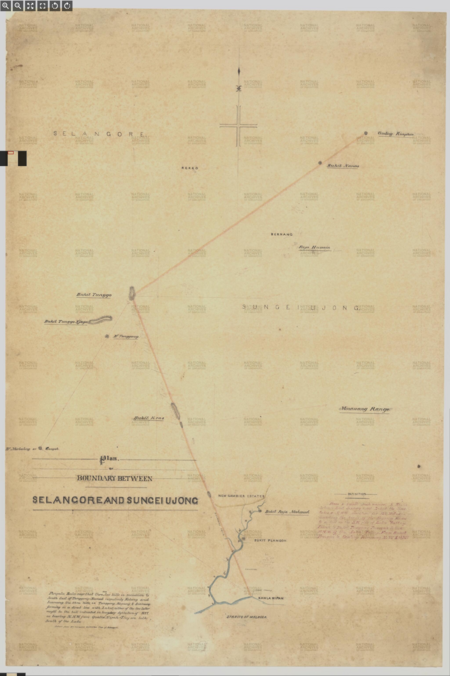
Kiri: Peta Selangor-Sungai Ujong tahun 1877, bersama cadangan awal persempadanan baru: “Map shows track from Seramban (Seremban) to Labu Valley surveyed by B. Douglas, HBM's Resident, Selangor” (
Survey Department, Singapore, 15/10/1877: |"Track From Seramban (Seremban) To Labu Valley").
Kanan: Peta cadangan sempadan Selangor-Sungei Ujong (1877), bersama perincian cadangan. Antaranya, Bukit Tunggul menjadi salah satu mercu tanda serta bucu sempadan tersebut: “Plan Of Boundary Between Selangore And Sungei Ujong, 1877: Plan shows boundary between Selangore (Selangor) and Sungei Ujong at Selangor, Malaya, and a few references, like hills. Extract from Mr Cameron's exploration map of Selangor. … From a small creek named S. Nipha between East Sepang and Lukut the line takes a N.N.W. direction for 12 1/2 Miles, avoiding the heads of the Sepang Rivers to a hill on the S.W. side of Labu Valley. Thence to Bukit Tunggu (Tunggah to the W.N.W. of the ? ? . From Bukit Tunggu to Ginting Rimphung N.73' E.6 ? … Pengalu Bala says that there are two hills in succession to South East of Tanggong - Named respectively Kobang and Siamang in a direct line with Lukut, either of the two latter might be the hill indicated in boundary definition of 1877, as bearing N.N.W. from Qualla Nipah - They are both South of the Labu.” (Survey Department, Singapore, 1877: |"Plan Of Boundary Between Selangore And Sungei Ujong").
LATAR PERISTIWA: Rekoh.
LATAR PERISTIWA: Hutan Simpan Bukit Tunggul.
1880-07-30: Penyerahan Lukut kepada Sungai Ujong
Sementara itu, Lukut pula diserahkan kepada Sungai Ujong secara rasmi dalam suatu rundingan di Singapura pada 30 Julai 1880:-
- “Surat persetujuan penyerahan Lukut kepada Sungai Ujong telah dicapai setelah satu rundingan di antara Paduka Sri Sultan Abdul Samad Selangor, Dato’ Kelana Sungai Ujong – Tunku Syed ‘Abdu’l Rahman bin Syed Ahmad al-Qadri [Waris Hilir], Tunku Klana Petra Sri Jaya, Raja Bot Bin Raja Jumaat [ Raja Lukut ] dan Raja Daud bin Raja Sulaiman Ibni Almarhum Sultan Muhammad Shah [ Penghulu of Sungai Raya dan Ulu Langkat ] yang telah diadakan di Singapura pada 30.07.1880. Melalui persetujuan yang ditandatangani ini bersama ini penyelesaian hal Lukut yang telah dimasukkan ke dalam Daerah Sungai Ujong. Melalui surat persetujuan ini berakhirlah pemerintahan Raja Bot dan ayahya Raja Juma’at ke atas Lukut yang memakan masa 32 tahun. Melalui perjanjian ini juga Raja Bot dan keluarga beliau menerima wang berjumlah RM 27,000. Pertikaian berkenaan daerah Lukut bermula apabila pada tahun 1862 Y.A.M. Dato’ Sending [Waris Hulu], Dato’ Shah Bandar, Dato’ Klana Petra Sri Jaya, yang menjadi Dato’ Kelana Sungai Ujong beliau menuntut daerah Lukut dan mengatakan Lukut sebahagian daripada daerah Sungai Ujong. Ekoran daripada ini rundingan-rundingan telah diadakan di antara pihak Selangor dan Sungai Ujong akhirnya pada hari ini 30 Julai 1880 penyelesaian telah dicapai berkaitan dengan masalah Lukut.” (Wangsa Mahkota Selangor, 13 Jun 2010: |"Perjanjian Sempadan Negeri Selangor dan Sungai Ujung 1880").
- “The results of the Sungai Ujong War and the event which followed it are too well known to need repitition. In the somewhat protracted negotiations which followed, Raja Bot found that his territory was to be forfeited, and he retired to Singapore with a solutium of $20,000 in his pocket.” (L.D. Gammans @ Journal of the Malayan Branch of the Royal Asiatic Society Vol. 2, No. 3 (92) (December 1924), pp. 291-295: "The State of Lukut. (With text figures)").
- “Raja Bot was not involved in the Klang War/Selangor Civil War (1867-1873) and Lukut was far away from the battlegrounds. After the war, the British started to gain stronger influence in the affairs of state with the implementation of the Residential system. In 1878, the British wanted to settle the long-standing boundary problem, brought up by Dato Kelana Sending of Sungai Ujong for a claim of the Lukut district including Cape Rachado (Tanjung Tuan today). Raja Bot, who was not consulted, protested strongly against the transfer of Lukut to Sungai Ujong. It was finally concluded in a convention held in Singapore on 31 July 1880 where Raja Bot was compensated with a total sum of 27,000 dollars.” (Eric Lim @ Museum Volunteers, JMM, August 23, 2021: |"A Very Rough Guide To Lukut").
- “When the frontier between Negri Sembilan and Selangor was settled in the 1880's the territory from Beranang Hilir northwards was given to Selangor but Lukut and its territory down to Cape Rachado were given to Sungei Ujong. The claims of Raja Hussein at Semunyeh were recognised and he was offered the choice of becoming penghulu of Semunyeh under the Sultan of Selangor or of becoming Dato' Laksamana of Sungei Ujong. He elected to be headman of Semunyeh but proved incompetent. After a long and patient trial he was deprived of his office and replaced by a kinsman. The kinsman also was incompetent and so the office passed out of the family. The corresponding Lukut question was settled more easily by the payment of $20,000 to Raja Bot, the last Selangor headman. To this day waris of Sungei Ujong still reside at Semunyeh and the boundary was a very sore point with His Highness the late Yang di-Pertuan Besar, Negri Sembilan, who continued to assert the old claim until his death in 1933, by sending letters to the Sultan of Selangor and even by seeking an interview with His Majesty the King at Buckingham Palace in 1925. The question is now considered closed.” (J. M. Gullick @ Journal of the Malayan Branch of the Royal Asiatic Society Vol. 22, No. 2 (148), Sungei Ujong (May 1949), pp. 1-69: "Sungei Ujong", m.s.3-4).
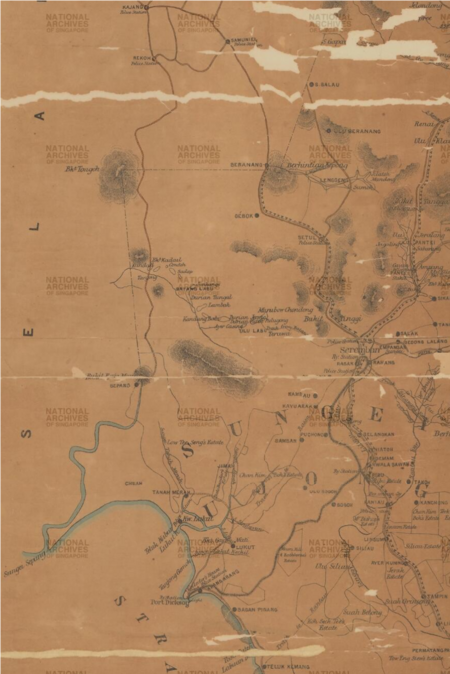
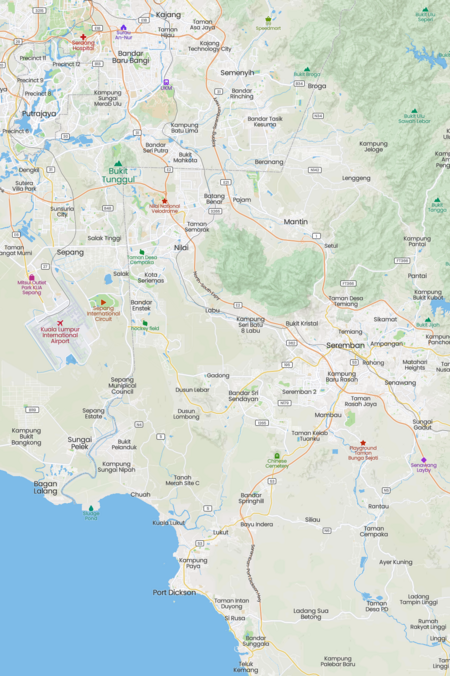
Kiri: Peta sempadan Selangor-Sungei Ujong, 1894 (14-16 tahun selepas perjanjian 1878 dan 1880). Bukit Tunggul telah menjadi mercu tanda serta bucu sempadan secara muktamad, dan kekal sehingga kini: “Map covers districts of Sungei Ujong and Jelebu in Negri Sembilan, Malaya showing towns, names of places, villages, roads, railways, tracks, rivers, rubber plantations, hills, Seremban, Port Dickson, and others” (Survey Department, Singapore, 1894: |"Map of the States of Sungei Ujong and Jelebu, 1894").
Kanan: Peta sempadan Selangor-Negeri Sembilan, kini (Mapcarta).
Peninggalan
Kota Lukut (1847)
Kota Lukut dibina pada 1840an, ketika pemerintahan Raja Jumaat (1846-1864). Di tapaknya kini didirikan Muzium Lukut:-
“Pada tahun 1815 Raja Busu anak kepada Raja Muhammad, Sultan Selangor ke-3 yang memerintah dari tahun 1826 - 1858 memerintah di Lukut mengambil keputusan untuk mengeksport bijih timah yang dilombong di daerah Seremban dan Lukut melalui pelabuhan Lukut. Dalam satu pergaduhan antara pelombong-pelombong bijih timah kaum Cina, Raja Busu dibunuh pada tahun 1834, akibat pembuuhan itu Keadaan masyarat menjadi kucar kacir dan pelombong- pelombong bijih lari meninggalkan Lukut. Pada tahun 1846 Raja Muhammad melantik Raja Jumaat bin Raja Jaafar dari Riau (menantu baginda) untuk menguatkan pemerintahannya, bagi membina sebuah kota yang dinamakan Kota Lukut. Kota Lukut dibina pada 1840an dengan ukuran 607 kaki panjang, 505 kaki lebar dengan parit di sekitar sedalam 15 kaki, di dalamnya didirikan sebuah istana dan dua buah perigi. Sebuah di bahagian luar dikenali sebagai Perigi Beracun. Di dalam pemerintahan Raja Jumaat, pembangunan Lukut menjadi bertambah maju dan makmur.”
(Sumber: Majlis Perbandaran Port Dickson, 2016: |"Muzium Lukut").
“Kota Lukut/Lukut Fort [3] was the fortification that Raja Jumaat built on top of Bukit Gajah Mati in 1847. The fort is rectangular, measuring about 200 metres long and 170 metres wide, and surrounded by a 5-metre broad ditch with a wall of sharpened bamboo stakes as a first line of defence against intrusion. Cannons were mounted at the edges of the fort. At the centre lies the remains of the house that Raja Jumaat built for his daughter, Raja Wok, and located outside was a sepak raga (sepak takraw today) court. There are two wells within the fort, of which one was a poisoned well used for executions. There are also remains of several cisterns sunk in the ground.” (Eric Lim @ Museum Volunteers, JMM, August 23, 2021: |"A Very Rough Guide To Lukut").
“Raja Jumaat mendirikan Kota Lukut yang berukuran 607 kaki panjang dan 505 kaki lebar dan parit se dalam 15 kaki di sekelilingnya. Turut didirikan oleh Raja Jumaat ialah meriam-meriam dan peluru-peluru disumbat dari mulut yang diletakkan di sekeliling Kota Lukut. Dipercayai meriam-meriam tersebut dibeli dari pihak Belanda di Melaka.”
(Sumber: Zulkapli Othman; Mohd Khalid Yasin @ Warisan: Jurnal Persatuan Sejarah Malaysia cawangan Negeri Sembilan 18 m.s.59-37 (1994): |"Sejarah Lukut", m.s.2,5-6).
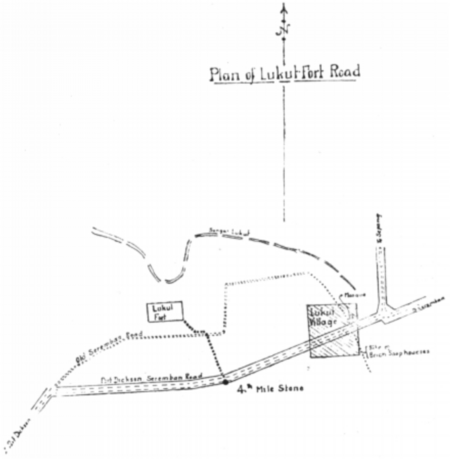
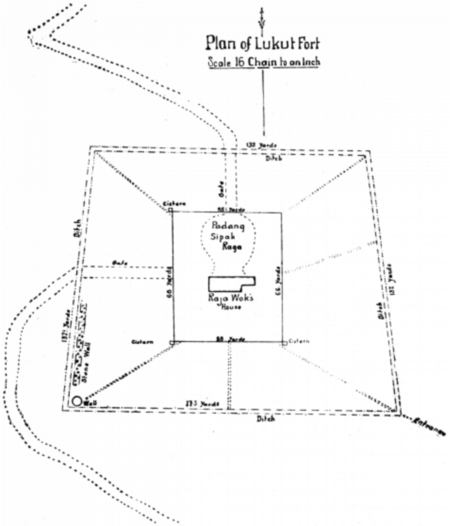
Kiri: “Plan of Lukut Fort Road”
Kanan: “Plan of Lukut Fort”
“He (Raja Jumaat) instituted a police force of 22 Malays, who not only wore uniform but had numbers on their hats, and built the Lukut Fort on Bukit Gajah Mati overlooking the settlement on the river. Within its walls he built a house for his daughter Raja Wok, who afterwards married her cousin Raja Muhammad. Cannons were purchased and the ditches deepended so that the little settlement had near by a strong rallying point within which it could take shelter in case of trouble. … The Lukut Fort. The Fort stands on an eminence known as Bukit Gajah Mati several hundred feet high. Its tactical position is excellent: not only does it effectively command the river and the settlements of Lukut down below, but from it a clear view to the sea can be obtained. The Fort is rectangular and consists of an outer ditch about 10—12. feet deep in in a good state of preservation. The earth from the ditch has been thrown up as a rampart: in one part at the South-West corner stone wall has been erected to protect the well. In two places the wall has been pierced to form entrance gates on the North and West sides and an entrance road winds round the hill and joins the old Seremban road which ran at the bottom. The sides of the entrance road have been built up with uncemented bricks to prevent erosion. In the centre of the fort stands the remains of the house, which Raja Jumaat built for his daughter Raja Wok. Judging by the foundations, the house must have been considerably larger than at present appears. Some very good Malay carving has been removed and placed in the Museum at Kuala Lumpur, for safe custody. The North-West corner of the fort adjoining the house is considerably higher than the remainder: this raised portion may have been constructed to give a clear field for fire over the heads of the defenders at the ramparts, or it may have been intended to place a similar raised platform all round the house for protection. On the north side of the house in front of the larger entrance gate traces remain of the small padang where sepak ragak was played. The armament of the Fort consisted of a number of muzzle loading cannons mounted at various spots. These cannons now stand in front of the Police Station at Port Dickson and facing the sea in front of the District Officer's house. The ditch was protected by sharpened stakes. The defenders were armed as far as possible with old muzzle-loading guns. One of the chief problem of the Fort was the water supply : a very deep well was sunk at the South-West corner and a wall erected to protect it. This well proved practically useless, only giving water in the wettest season. A number of large brick cisterns sunk in the ground were constructed and refilled at intervals by water brought up from below in buffalo carts. Three of the cisterns still remain.”
(Sumber: L.D. Gammans @ Journal of the Malayan Branch of the Royal Asiatic Society Vol. 2, No. 3 (92) (December 1924), pp. 291-295: "The State of Lukut. (With text figures)").
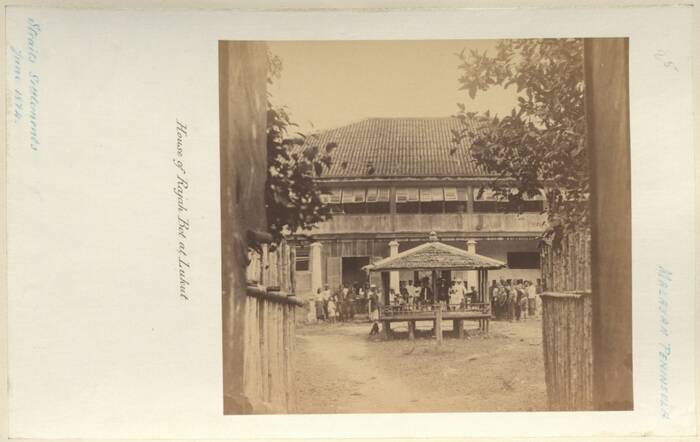
“House of Rajah Bot at Lukut. Straits Settlements June 1874.” (The National Archives UK, June 1874: |"CO 1069-484-114").
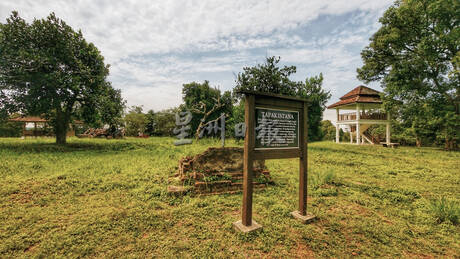
Tapak Istana Raja Wok kini: “Setelah 170 tahun, banyak binaan tidak lagi dapat dikembalikan kepada keadaan asalnya”.
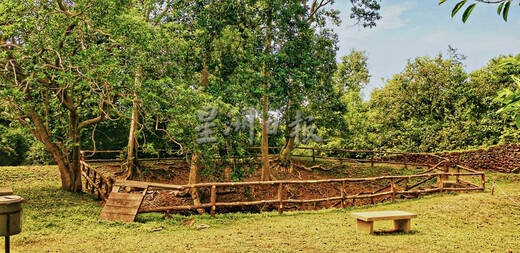
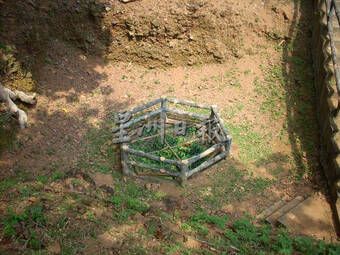
Perigi Beracun: “Perigi beracun, tempat hukuman penjenayah dan tahanan, kini ditutup dan diliputi semak-samun.”
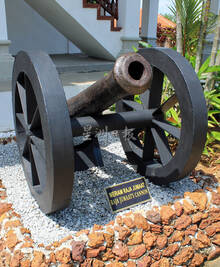

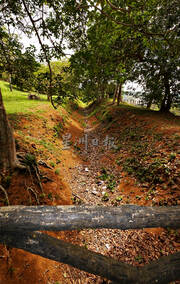
Kiri: Meriam Raja Jumaat: “Meriam di hadapan kota, kini bahan pameran”.
Kanan: Parit di sekeliling kota.
(Sumber gambar-gambar: Sin Chew Daily, 13/01/2022: |"昔日战壕褪尽铅华 回顾芦骨从兴至衰的“末代王朝”").
“Misterinya adalah persoalan kehilangan istana di Kota Lukut berdasarkan jarak masa sekarang dengan pemerintahan Raja Bot. Sehingga hari ini, pihak muzium Kota Lukut sendiri masih tertanya-tanya ke mana hilangnya istana Kota Lukut, sedangkan jarak masa dengan sekarang tidak sampai beratus tahun. Mengikut kajian, Kota Lukut ditemui berdasarkan struktur binaan di atas bukit Gajah Mati yang dibina seperti sebuah kubu perang. Yang dijumpai dalam eskavasi pada 1940 hanyalah tapak tiang dan serpihan seperti peralatan dalam rumah.” (SENTIASAPANAS.com, 11/05/2018: |"Misteri Kehilangan Istana Kota Lukut").
Masjid Kariah Lukut (1872/1815)
Menurut rekod di Jabatan Kemajuan Islam Malaysia (JAKIM), masjid ini dibina pada tahun 1872 ketika pemerintahan Raja Jumaat. Tarikh ini kurang tepat kerana Raja Jumaat dilantik sebagai Raja Lukut pada tahun 1846, dan mangkat pada tahun 1864. Beliau juga bukan Raja Lukut yang pertama:-
- “Masjid Kariah Lukut telah dibina pada tahun 1872M ketika pemerintahan Raja-Raja Melayu Lukut dan pengasasnya ialah Raja Jumaat iaitu Raja Lukut pertama. Setiap tahun dalam bulan Sya'ban DYMM Sultan Selangor akan berangkat untuk menziarahi Makam Diraja Lukut. Masjid ini pernah dibaiki dan dinaik taraf pada tahun 1960M, 1995M, 1998M dan 2008M dan 2009M. Pada awal pembinaan masjid, ahli jemaah cuma 100 orang sahaja dan kini telah mencapai bilangan seramai 800 orang.” (Jabatan Kemajuan Islam Malaysia (JAKIM): |"MASJID KARIAH LUKUT").
- “In 1846, Sultan Muhammad announced the appointment of Raja Jumaat as Chief of Lukut. Prior to this, Raja Jumaat together with his father, Raja Jaafar and brother, Raja Abdullah, had settled in Lukut for some time. They were Bugis from Riau, Indonesia. … When Raja Jumaat died in 1864, it was a big blow to Lukut as it began to decline and the situation was made worse with the gradual depletion of its tin deposits.” (Eric Lim @ Museum Volunteers, JMM, August 23, 2021: |"A Very Rough Guide To Lukut").
Menurut Tn Hj Abd Hamid bin Abdullah PJK (Pengerusi Masjid Qaryah Lukut 1990-2017), ia dibina seawal pemerintahan Raja Busu (Raja Lukut yang pertama) pada tahun 1815, dan kini berusia lebih 200 tahun. Dindingnya dilepa dengan campuran putih telur, dan perigi wuduk yang dibina ketika itu masih digunakan sehingga kini:-
“Masjid Qaryah Lukut merupakan sebuah masjid peninggalan sejarah yang telah dibina semasa pemerintahan Almarhum Raja Busu atau nama sebenarnya Raja Hassan ibni Raja Nala, pada tahun1815, dan pada tahun 1834M Raja Jumaat ibni Raja Jaafar pengambil alih pemerintahan Lukut,Baginda merupakan menantu kepada Sultan Muhammad Shah Sultan selangor yang ketiga,telah mengahwini puteri Tuanku, bernama Tengku Senai atau Tengku Nai. Baginda telah mengkat pada tahun 1864M Raja Jumaat adalah kerabat di raja Riau. Raja Jumaat datang ke Lukut bersama-sama Raja Abdullah yang dibawa oleh ayahandanya yang bernama Raja Jaafar bin Raja Ali dari kerabat di raja Riau. Masjid ini pada asalnya berkeluasan 45 kaki panjang dan 45 kaki lebar semasa dibina dan telah berusia 196 tahun. Sejak pembinaannya, masjid ini mengunakan air perigi untuk jemaah berwuduk. Perigi tersebut masih lagi digunakan sehingga sekarang. Selain itu, fakta sejarah ada menyatakan bahawa binaan dinding masjid ini dilepa dengan campuran putih telur. Pada setiap tahun dalam bulan Syaaban, DYMM Sultan Selangor dan kerabat akan berkunjung ke Makam Diraja Lukut yang terletak berhadapan dengan Masjid Qaryah Lukut.”


Gambar Masjid Kariah Lukut, diambil pada tahun 1987.
(Sumber: Tn Hj Abd Hamid bin Abdullah PJK (Pengerusi Masjid Qaryah Lukut 1990-2017): |"MASJID QARYAH LUKUT").
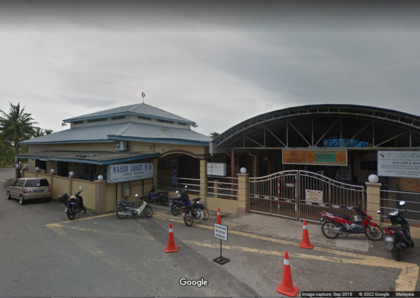

Kiri: Masjid Kariah Lukut, kini (Google Street View, 2018).
Kanan: Plak rasmi menyatakan Masjid Lukut dibina tahun 1872, ketika pemerintahan Raja Jumaat (Azlan Sharif @ Facebook, 7 April 2022: |"masjid kariah lukut").
Makam Diraja
Makam Raja Busu (1834)
“There are two Selangor royal tombs in Lukut. The first one is located at a hillock at Kampung Kuala Lukut (now Chuah) [1]. This is where Raja Busu and his family members were buried. Earlier, there was a plan to upgrade it to reflect it as a Royal Tomb but this did not materialise.” (Eric Lim @ Museum Volunteers, JMM, August 23, 2021: |"A Very Rough Guide To Lukut").
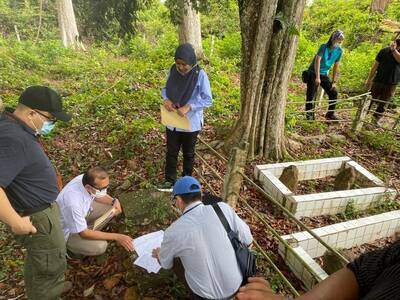
“Perancangan Kerja Naiktaraf Makam Raja Busu (Kerabat DYMM Sultan Selangor).” (Zulkhairi Abd Aziz @ Twitter, 24 Mac 2021: "Perancangan Kerja Naiktaraf Makam Raja Busu").
“His grave stands to-day on the hill overlooking the Custom Station at Kuala Lukut and is still an object of veneration in the neighbourhood.” (L.D. Gammans @ Journal of the Malayan Branch of the Royal Asiatic Society Vol. 2, No. 3 (92) (December 1924), pp. 291-295: "The State of Lukut. (With text figures)").
Makam Raja Jumaat (1864)
“The other is Raja Jumaat’s tomb at the Selangor Royal Mausoleum [2] located inside the Lukut Muslim Cemetary. It is easy to find the place as it is opposite the Lukut Police Station and adjacent to a petrol station. As far back as 1855, it was designated as the final resting place of members of the Selangor royal family. The Selangor state government is still paying to the local authority for use of the land.” (Eric Lim @ Museum Volunteers, JMM, August 23, 2021: |"A Very Rough Guide To Lukut").

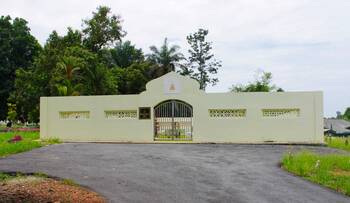

“Terletak di Kawasan Makam Di Raja Selangor, di Kawasan Perkuburan Islam Lukut. Kawasan Perkuburan berkenaan berhadapan dengan Balai Polis Lukut, bersebelahan dengan stesen minyak Caltek.” (Sang Ekstasi, 6 Oktober 2012: |"Makam Raja Jumaat").
Raja Bot bin Raja Jumaat (1847-1916)
Raja Bot Bin Raja Jumaat, putera Raja Jumaat, adalah pemerintah terakhir Lukut, sebelum diserahkan kepada Selangor dalam perjanjian 1880 di atas:-
- 1847 (Disember): Dilahirkan di Lukut: “Raja terakhir memerintah sebagai wakil kepada Sultan Selangor di Lukut adalah Raja Bot atau nama sebenarnya Raja Muhammad Saleh, anak kepada Raja Jumaat yang dilahirkan di Lukut pada Disember 1847.” (SENTIASAPANAS.com, 11/05/2018: |"Misteri Kehilangan Istana Kota Lukut").
- 1857-1858: Dipelihara oleh Lieutenant Colonel Ronald MacPherson (Resident Councillor (chief administrator) Melaka 1857-1860), bersekolah di sekolah Inggeris di Melaka:-
- “Sebenarnya, kira-kira tahun 1857, dan tahun 1858, putera Raja Jumaat, iaitu Raja Bot, dipelihara oleh Macpherson. Dia melayan Raja Bot sebagai anaknya sendiri dan menghantarnya ke sekolah Inggeris di Melaka.” (Sumber: Zulkapli Othman; Mohd Khalid Yasin @ Warisan: Jurnal Persatuan Sejarah Malaysia cawangan Negeri Sembilan 18 m.s.59-37 (1994): |"Sejarah Lukut", m.s.8).
- “Raja Bot became the new Ruler of Lukut. Raja Bot was born on 4 December 1847; at the age of ten, he was sent to Malacca to study in an English school and stayed for ten months with Macpherson. He was then sent to Baba Chi Yam Chuan where he helped with reading and writing of Malay letters from and to Lukut. At thirteen, he was helping to look after his father’s business in Lukut.” (Eric Lim @ Museum Volunteers, JMM, August 23, 2021: |"A Very Rough Guide To Lukut").
- 1865: Mengambil alih pemerintahan Lukut, manakala abang tiri beliau Raja Jahya menjadi timbalan. Walaupun tidak dapat meneruskan kegemilangan bapanya, beliau tetap dianggap pemerintah yang baik: “On Raja Jumaat's death, he was buried in the small cemetery at Lukut where his grave to this day is still upkept by the Selangor Government, and was succeeded by his son Raja Bot, who appears to have been unable to carry on to the same extent the good work which his father had begun, but nevertheless was equally popular with all races and was considered a good ruler.”
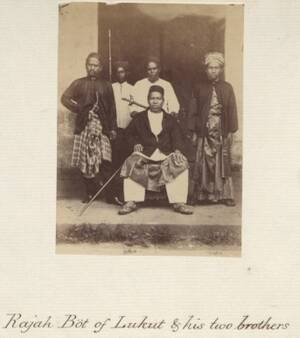
“Rajah Böt of Lukut & his two brothers.” (The National Archives UK, 1860-1900: |"CO 1069-484-125").
- 1880: Lukut diserahkan kepada Sungei Ujong. Raja Abdul Kadir, anak kepada abang tiri beliau Raja Jahya, menjadi Penghulu Port Dickson selama beberapa tahun: “He (Raja Bot) had a half brother Raja Jahya, older than himself, but ineligible to succeed his father owing to the fact that his mother was not of royal birth. Jahya deputised for his younger brother when the latter was a absent from the Settlement. He was the father of Raja Abdul Kadir who for many years was Penghulu Port Dickson and died a few years ago.”
- 1887: Penghulu Sungai Buloh:-
- “Dalam catatan di Muzium Lukut, Raja Bot dikatakan mengambil alih pemerintahan pada 1865, kemudian beliau dilantik menjadi Penghulu Sungai Buloh pada 1887.” (SENTIASAPANAS.com, 11/05/2018: |"Misteri Kehilangan Istana Kota Lukut").
- “He sought employment from the Selangor government but he was denied. In June of 1887, he applied for the post of Penghulu of Sungai Buloh and this time, Bot was successful.” (Eric Lim @ Museum Volunteers, JMM, August 23, 2021: |"A Very Rough Guide To Lukut").
- 1888 (18 Disember): Ahli Majlis Negeri Selangor.
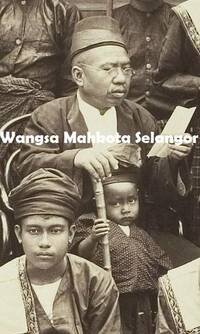

Kiri: Raja Bot Bin Raja Jumaat (Wangsa Mahkota Selangor, 13 Jun 2010: |"Perjanjian Sempadan Negeri Selangor dan Sungai Ujung 1880").
Kanan: “RAJA BOT (duduk tengah) bergambar bersama ahli keluarganya sekitar 1912, kira-kira 32 tahun selepas penyerahan Lukut kepada Sungei Ujong. ” (SENTIASAPANAS.com, 11/05/2018: |"Misteri Kehilangan Istana Kota Lukut").
- 1895 (5 Disember): Memohon lesen perlombongan di Mukim Setapak (Arkib Negara 1957/0052128W, 05/12/1894: |"RAJA BOT'S APPLICATION FOR MINING LICENSE (SETAPAK). RESTRICTION ACTS MINING ON CERTAIN AREA - ULU KLANG").
- 1916 (11 April): Meninggal dunia setelah menghidap penyakit asma dan jantung. Dikebumikan di Tanah Perkuburan Diraja Johor Bahru: “However, it was a short stint and his next posting was as a member of the State Council on 18 December 1888 where he stayed until his passing on 11 April 1916. He died of asthma and heart failure; he was buried at the Royal Burial Ground at Johor Bahru.” (Eric Lim @ Museum Volunteers, JMM, August 23, 2021: |"A Very Rough Guide To Lukut").



